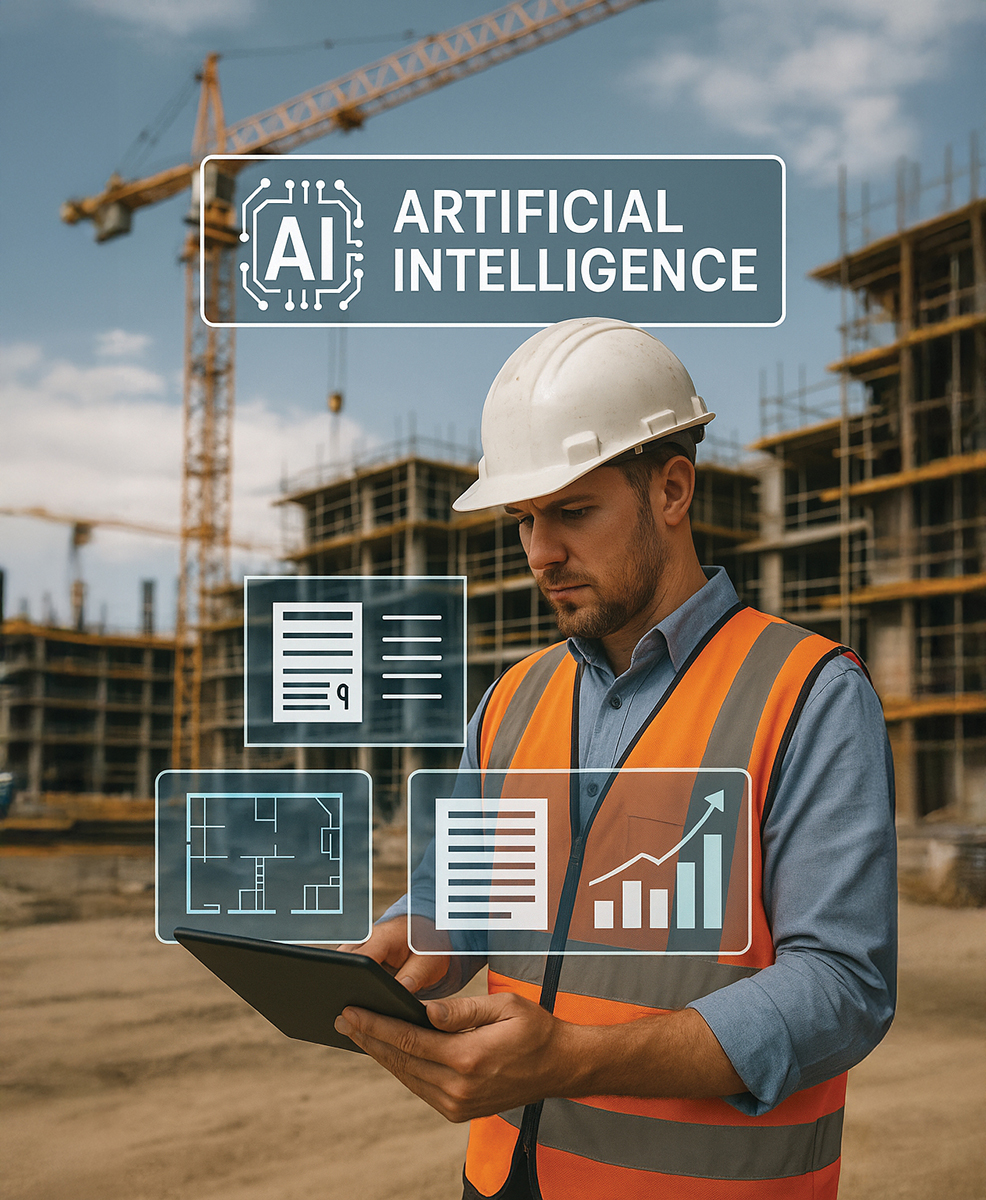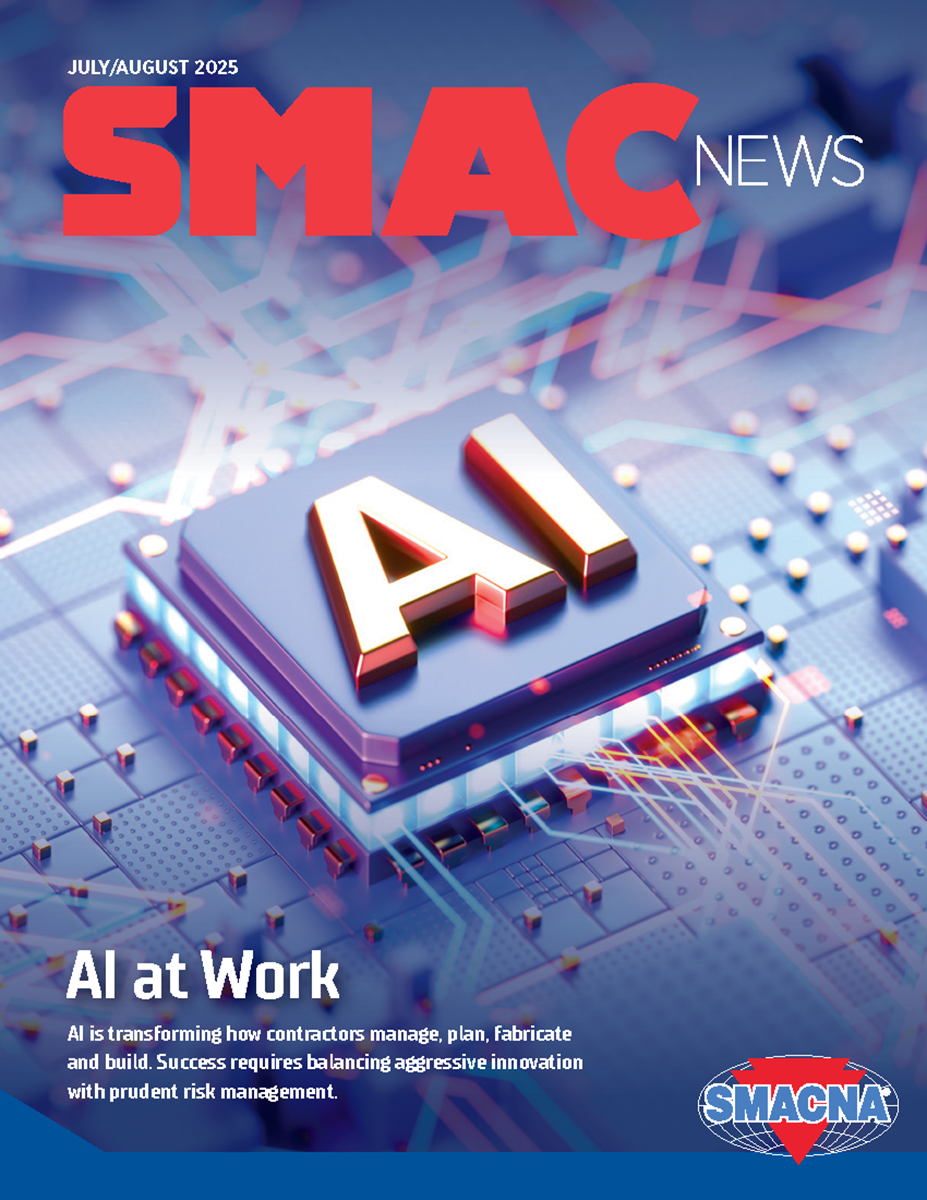AI in Construction: Navigating Opportunities and Risks for SMACNA Contractors
These next few years will be important for the construction industry, as artificial intelligence transforms key elements of how contractors operate.
 For SMACNA members, this technological shift presents both opportunities and challenges. As AI adoption accelerates across the industry, understanding its implications will be essential for growth and increasing margins, while keeping a firm grasp on the risks AI can present.
For SMACNA members, this technological shift presents both opportunities and challenges. As AI adoption accelerates across the industry, understanding its implications will be essential for growth and increasing margins, while keeping a firm grasp on the risks AI can present.
The rapid emergence of AI technologies — from machine learning algorithms that optimize ductwork design to natural language processing systems that automate documentation- is beginning to fundamentally reshape how contractors bid, build, and deliver projects. This transformation brings complexities that require thoughtful consideration and strategic planning.
First, the Opportunities
AI tools are accessible to anyone with a keyboard, and more and more people are getting used to using chatbots and other tools in their day-to-day. This fluency promises to spill over into the workplace, giving teams new tools and skillsets they can use to drive efficiency and control risk, as well as elevating the most critical skills by automating repetitive, time-wasting tasks.
Here are some ways AI promises to improve the lives and work of contractors:
Revolutionizing Document Management
AI offers transformative benefits for document-heavy construction processes. AI technology can eliminate up to 90% of PO processing time while automatically identifying billing errors, which can save contractors 5% to 10% in material costs. For SMACNA contractors managing dozens, hundreds, even thousands of purchase orders, specifications, submittals and compliance documents, AI-powered systems can dramatically reduce administrative burden while improving accuracy.
These systems go beyond simple automation. They can identify patterns in vendor pricing, flag unusual charges, and even predict potential supply chain disruptions based on historical data.
Mitigating Field Risks
AI's predictive capabilities shine in field safety applications. Computer vision systems can monitor job sites 24/7, identifying safety violations that human supervisors might miss. These systems can detect workers without hard hats, identify improper ladder usage and even recognize fatigue patterns that precede accidents. Real-time alerts can enable immediate intervention, preventing injuries before they occur.
Environmental monitoring represents another frontier. AI systems can continuously analyze air quality data during renovation projects, ensuring worker safety and regulatory compliance. They can predict when conditions might exceed exposure limits and automatically trigger ventilation adjustments or work stoppages.
Productivity Gains That Matter
Construction professionals currently spend way too much of their time searching for information on projects. AI-powered search and retrieval systems can slash this waste, connecting workers with the exact specifications, drawings or procedures they need instantly. Natural language queries like "show me the rooftop unit specifications for the third floor" can instantly retrieve relevant documents from thousands of project files.
 Beyond search, AI enables entirely new workflows. Generative design tools can explore thousands of ductwork configurations overnight, optimizing for multiple parameters simultaneously, airflow efficiency, material usage, installation accessibility and cost. What once required weeks of manual iteration can now happen in hours, with AI presenting ranked options that meet all project constraints.
Beyond search, AI enables entirely new workflows. Generative design tools can explore thousands of ductwork configurations overnight, optimizing for multiple parameters simultaneously, airflow efficiency, material usage, installation accessibility and cost. What once required weeks of manual iteration can now happen in hours, with AI presenting ranked options that meet all project constraints.
Transforming Recruitment
scan thousands of resumes to identify candidates with the specific certifications and experience SMACNA contractors need, from certified welders to TAB technicians. But the technology can go deeper, analyzing patterns to predict candidate success and cultural fit based on historical hiring data.
Chatbots handle initial screening questions around the clock, ensuring no promising candidate is lost due to delayed response. They can answer questions about benefits, schedule preliminary interviews, and even conduct basic skills assessments. This frees HR teams to focus on high-value interactions with qualified candidates, improving both efficiency and candidate experience.
Enabling Process Innovation
Perhaps AI's greatest promise lies in enabling entirely new ways of working. Machine-learning algorithms analyzing historical project data can identify patterns that predict delays or cost overruns with remarkable accuracy. By examining factors like weather patterns, material lead times, and crew productivity across hundreds of projects, AI can flag risks that human planners might miss.
Integration with Building Information Modeling (BIM) opens even more possibilities. AI can automatically check designs for code compliance, identify clashes before installation begins, and even suggest optimal installation sequences based on site conditions and crew availability. Some contractors report 30% reductions in coordination time through AI-powered clash detection and resolution.
Many of these opportunities will take some time, as managers become more comfortable with AI and begin to explore its capabilities. In fact, what we’ve seen already is that once construction leaders and field professionals get to a certain level of capability with AI, they start to find ways it can help both large and small companies. The true power of AI is giving teams the ability to adapt software to exactly what they need.
The Double-Edged Sword: Risks AI Poses
Just like any software, AI involves some risks. Here’s a good introduction to some of the bigger challenges:
Data Access Policy Vulnerabilities
The foundation of AI systems rests on data, documents and knowledge. For construction companies, this creates immediate concerns about data access and governance. AI systems require access to sensitive information, including infrastructure blueprints, cost estimates, client specifications and resource management plans, making them attractive targets for malicious actors. Without proper data access policies, contractors risk exposing proprietary fabrication methods, client details and competitive advantages that took decades to develop.
The challenge extends beyond external threats. Internal data access policies must address how AI systems interact with different levels of sensitive information. What historical project information can be fed into third-party AI tools? Can subcontractor data be included in AI training sets? These questions require clear, enforceable policies that balance innovation with security.

Consider a scenario where a well-meaning project manager uploads years of bid data to an AI tool for analysis. Without proper controls, this action could inadvertently expose pricing strategies, material sourcing relationships and proprietary installation methodologies to competitors if the AI platform experiences a breach or inappropriately uses the data for training public models.
Accuracy Concerns and Meeting Documentation
AI's promise of automated meeting transcription and documentation has captivated many contractors, but accuracy remains a persistent concern. When AI misinterprets technical discussions about HVAC specifications, refrigerant requirements or fabrication tolerances, the consequences can cascade through entire projects.
The nuanced nature of construction conversations, with their mix of technical jargon, regional terminology and project-specific abbreviations, poses unique challenges for AI systems trained on general datasets. When a superintendent mentions "fishmouth" or "Pittsburgh lock," will the AI accurately capture these industry-specific terms and their implications for the project?
The Erosion of Critical Skills
Perhaps most concerning is AI's potential to erode fundamental skills within the workforce. As contractors increasingly rely on AI for load calculations, psychrometric analysis and ductwork optimization, there's a risk that essential technical expertise may atrophy. Young professionals entering the field might bypass the foundational learning that comes from manual calculations and hands-on problem-solving.
This dependency creates vulnerabilities when AI systems fail or produce questionable results. Without the underlying knowledge to verify AI outputs, contractors may blindly follow flawed recommendations, potentially compromising project safety and quality. Imagine a scenario where an AI system recommends a duct size based on incomplete data, and no one on the team possesses the experience to recognize that the recommendation violates basic airflow principles.
The risk extends to field personnel as well. As AI-powered tools handle increasingly complex tasks, from automated layout to robotic fabrication, the craftspeople who built their careers on these skills may find their expertise devalued. This could create a dangerous knowledge gap where the industry loses the very expertise needed to train and validate AI systems.
Cybersecurity Threats
The cybersecurity landscape for construction AI presents unique challenges. AI systems face risks from attackers who "shift focus from stealing data to poisoning the AI models themselves." For construction companies, this represents a new frontier of cyber risk. Compromised AI models could provide access to customer information, or lead to incorrect answers.
The interconnected nature of modern construction projects amplifies these risks. IoT devices monitoring equipment performance, sensors tracking environmental conditions and integrated project management platforms all represent potential entry points for attackers. A breach in one system can cascade through integrated platforms, affecting everything from BIM models to financial systems.
As AI tools proliferate, contractors face the challenge of employees using personal or unapproved AI applications for work tasks. This "shadow AI" phenomenon creates multiple risks: data leakage through consumer-grade tools, inconsistent outputs across teams and potential intellectual property violations. Without clear policies, sensitive project information could end up training public AI models, benefiting competitors.
A foreman might use a free AI app to quickly generate a materials list, unknowingly uploading proprietary assembly details. An estimator could rely on an AI chatbot for code interpretations, receiving guidance that hasn't been verified for local jurisdictions. These individual actions, while well-intentioned, can create liability exposure and competitive disadvantages that compound over time.
Crafting Effective AI Policies
Early Stage: Foundation Building
For contractors just beginning their AI journey, success starts with solid foundations:
Governance Structure: Create an AI steering committee combining IT, operations, field personnel and leadership perspectives. This group should meet regularly to evaluate tools, assess risks and guide implementation. Include both AI enthusiasts and skeptics to ensure balanced decision-making.
Data Classification: Develop clear schemes identifying what information can be used with AI tools. Create categories like "Public" (marketing materials), "Internal" (general procedures), "Confidential" (project specifics) and "Restricted" (client data, pricing strategies). Each category should have clear handling requirements and approved use cases.
Tool Approval Process: Establish a formal process for evaluating and approving AI tools. Consider factors like data security, vendor stability, integration capabilities and total cost of ownership. Start with pilot programs on non-critical projects before widespread deployment.
Training Foundation: Implement basic training on AI capabilities and limitations. Every employee should understand what AI can and cannot do, recognizing both its potential and its pitfalls. Include real-world examples relevant to their daily work.
Mid Stage: Systemic Integration
As AI adoption matures, policies must evolve to address more complex scenarios:
Verification Protocols: Develop specific procedures for verifying AI outputs in critical applications. For example, any AI-generated load calculation must be spot-checked by a qualified engineer. Establish clear thresholds for when human verification is mandatory versus optional. A critical point here is to make sure someone “owns” every output from the AI system.
Vendor Management: Create comprehensive assessment criteria for AI solution providers. Evaluate not just functionality but also data handling practices, model transparency and update procedures. Require vendors to provide regular reports on model performance and any identified biases or errors.
Conclusion: Balancing Innovation with Prudence
The construction industry's AI transformation is not a question of if, but how. SMACNA works to be one step ahead to ensure members have the resources and education to align with the growth curve. Success requires balancing aggressive innovation with prudent risk management.
replace them.
For SMACNA contractors, this means developing comprehensive strategies that address both opportunities and risks. It means creating policies that enable innovation while protecting against emerging threats. It means investing in both technology and training, ensuring teams can leverage AI effectively while maintaining the skills to work without it.
The future belongs to those who can harness AI's power while preserving the craftsmanship, judgment and expertise that define excellence in sheet metal and HVAC construction. By sharing experiences, best practices and lessons learned within the SMACNA community, contractors can collectively navigate this transformation, emerging stronger and more capable than ever before.
As we stand at this technological crossroads, one truth remains clear: the contractors who thrive will be those who approach AI with both ambition and wisdom, leveraging its capabilities to enhance their work while never forgetting that construction remains, at its core, a human endeavor built on skill, experience and dedication to quality.
Published: August 28, 2025
IN THIS ISSUE
A SMART Partnership
SMACNA's President reflects on his long history of collaboration with SMART General President Michael Coleman.
AI in Construction: Navigating Opportunities and Risks for SMACNA Contractors
These next few years will be important for the construction industry, as artificial intelligence transforms key elements of how contractors operate.
ARCHITECTURAL: Crafting a Custom Vision in Steel
Thompson Solutions Group brought Plan Architecture’s wood-look steel façade to life at Little Priest Tribal College, combining precision, speed and SMACNA-backed expertise.
Artificial Intelligence: An Introduction
Since late 2022, when ChatGPT was introduced, we’ve been hearing more and more about AI, usually with more hype than explanation.
HVAC: Welded With Precision, Driven by Purpose
MechOne builds more than ductwork as it shapes the future of Colorado’s HVAC industry.
INDUSTRIAL: Leading the Charge
Toronto Sheet Metal Contractors Association member Black & McDonald installed HVAC systems and duct for Ontario’s first electric vehicle battery plant. The work required extensive communication with numerous trades.
Making AI Work: Tips & Tricks for Contractors
We are in the midst of another technology revolution, one as important as the internet or mobile phones, with artificial intelligence (AI) tools becoming increasingly accessible and practical for contractors of all sizes.
Progress, Partnerships and Possibility
SMACNA's CEO examines some of the association's work in critical subject matter areas.
RESIDENTIAL: How Zipf-Air Boosted Profits by Going Residential
By flipping his business model and focusing on customer service, high-end brands and Indoor Air Quality, John Zipf turned a commercial-heavy HVAC company into a thriving residential operation.
Trump Backs Biden-Era EO Mandating PLAs for Large Federal Construction Projects
In a surprising continuation of his predecessor’s labor policy, President Donald Trump’s administration announced on June 12, 2025
Welcome New SMACNA Members
What’s in H.R. 1, The New Tax Bill, and What It Means for SMACNA Contractors
Workforce Evolution Trends: What Construction Leaders Should Know
The dynamics of the construction labor workforce are shifting, fueled by a growing labor shortage, evolving employee expectations and a sizable portion of the workforce nearing retirement.


